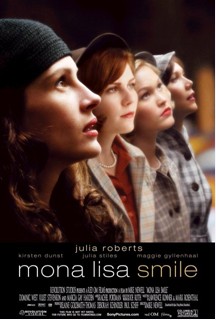发音:美式发音 语速:130词/分钟 使用方法:精听+复述
 前情提要:刚刚从UCLA(美国加州大学洛杉矶分校)毕业的凯瑟琳·沃森在大学里接受了自由思想,立志要成为一名杰出的教师。她来到了坐落在美国马萨诸塞州、被誉为“没有男子的常青藤”的韦斯理女子学院担任艺术史教师。在20世纪50年代初,在韦斯理这所著名的女子大学,学生们大都有着良好的家庭背景,但思想相对还是很保守,学院对学生的教育不是教他们如何去向自己感兴趣的方向发展,而是把学生的成功与否定义为是否能嫁一个好丈夫。凯瑟琳没有像其他老师那样沿袭学校一贯的教学风格,她不仅挑战学校的一些做法、规矩,而且鼓励学生发掘自己的兴趣,大胆去实践她们的想法。最终她以率直的个性,丰富的艺术史知识以及风趣热情的授课风格,赢得了学生们的尊敬和爱戴,被女学生们称为“蒙娜丽莎”。 下面这个片段就是凯瑟琳在韦斯理大学的第二节课。
前情提要:刚刚从UCLA(美国加州大学洛杉矶分校)毕业的凯瑟琳·沃森在大学里接受了自由思想,立志要成为一名杰出的教师。她来到了坐落在美国马萨诸塞州、被誉为“没有男子的常青藤”的韦斯理女子学院担任艺术史教师。在20世纪50年代初,在韦斯理这所著名的女子大学,学生们大都有着良好的家庭背景,但思想相对还是很保守,学院对学生的教育不是教他们如何去向自己感兴趣的方向发展,而是把学生的成功与否定义为是否能嫁一个好丈夫。凯瑟琳没有像其他老师那样沿袭学校一贯的教学风格,她不仅挑战学校的一些做法、规矩,而且鼓励学生发掘自己的兴趣,大胆去实践她们的想法。最终她以率直的个性,丰富的艺术史知识以及风趣热情的授课风格,赢得了学生们的尊敬和爱戴,被女学生们称为“蒙娜丽莎”。 下面这个片段就是凯瑟琳在韦斯理大学的第二节课。
(Slide)
Giselle: What is that?
Katherine: You tell me. 1)Carcass by Soutine, 1925.
Student 1: It’s not on the syllabus.
Katherine: No, it’s not. ①Is it any good? Come on, ladies. ②There’s no wrong answer. There’s also no textbook telling you what to think. It’s not that easy, is it?
Betty: All right. No. It’s not good. In fact, I wouldn’t even call it art. It’s 2)grotesque.
(放幻灯片)
杰斯丽:这是什么?
凯瑟琳:你来告诉我。苏蒂恩的《屠宰后的牲畜》,绘于1925年。
学生甲:教科书上没有。
凯瑟琳:的确,上面没有。这幅画怎么样?好吧,女士们,这里没有错误的答案。没有一本教科书能教你如何思考,不太容易接受,是吗?
贝蒂:哦,不。它很糟糕。实际上,我甚至不愿称它为艺术,如此怪诞丑陋。
Connie: Is there a rule against art being grotesque?
Giselle: I think there’s something 3)aggressive about it...and 4)erotic.
Betty: To you, everything is erotic.
Giselle: Everything is erotic.
Katherine: Girls.
康尼:有什么规定说怪诞丑陋的便不是艺术了?
杰斯丽:我觉得这里面富于侵略性……和色情。
贝蒂:对你来说,任何东西都是色情的。
杰斯丽:任何事物都与色情有关。
凯瑟琳:女孩们。

![]()
Susan: Aren’t there standards?
Betty: Of course there are. Otherwise a 5)tacky, velvet painting could be equated to a Rembrandt.
Connie: Hey, my Uncle Ferdie pretty has two tacky, velvet paintings. He loves those clowns.
Betty: There are standards, technique, composition, color, even subject. So if you’re suggesting that rotted side of meat is art, much less good art, then what are we going to learn?
Katherine: Just that. You have outlined our new syllabus, Betty. Thank you. What is art? What makes it good or bad? And who decides? Next slide, please. Twenty-five years ago someone thought this was brilliant.
苏姗:难道不存在标准吗?
贝蒂:当然存在。否则,艳俗的天鹅绒画亦可等同于伦伯朗的杰作。
康尼:嘿,我的叔叔费迪就有两张俗气的天鹅绒画,他爱死这些丑东西了。
贝蒂:艺术是有标准的,需要技巧,讲究构图,色彩,以及主题。因此如果你告诉我们这块腐烂的肉也算艺术的话,更别提还是艺术杰作,那么究竟我们要学什么?
凯瑟琳:就是这个。贝蒂,感谢你为我们概述了新的教学大纲。什么是艺术?怎样区分孰优孰劣?由谁来判定?请翻到下一页。25年前有人认为这张画精彩绝伦。
Connie: I can see that.
Student 2: Who?
Katherine: My mother. I painted it for her birthday. Next slide. This is my mom. Is it art?
Susan: It’s a snapshot.
Katherine: If I told you Ansel Adams had taken it, would that make a difference?
康尼:看得出来。
学生乙:这人是谁?
凯瑟琳:我的母亲,是我为她生日所画的。下一张,这是我的母亲。这也是艺术吗?
苏姗:一张快照而已。
凯瑟琳:如果我告诉你们这是安塞姆·亚当拍摄的呢?这是否会有不同的定论呢?
Betty: Art isn’t art until someone says it is.
Katherine: It’s art!
Betty: The right people.
Katherine: Who are they?
Giselle: Betty Warren! We’re so lucky we have one of ’em right here.
Betty: ③Screw you.
Katherine: Could you go back to the Soutine, please? Just look at it again. Look beyond the paint. Let us try to open our minds to a new idea.
贝蒂:艺术需由某些人来决定。
凯瑟琳:这就是艺术!
贝蒂:需经权威人士认可。
凯瑟琳:他们是谁?
杰斯丽:贝蒂·沃伦!多么荣幸我们中间就有一位。
贝蒂:去你的。
凯瑟琳:请回到苏蒂恩的作品,再看一遍,透过画面去看,让我们的心灵为新的思想打开一扇门。
Smart Sentences
① Is it any good? 这幅画怎么样?(文中释义)
Is it any good?: used to ask others to evaluate sth.(用以询问他人对某事的看法)。例如:
What about this table? Is it any good?
这张桌子怎么样?还可以吧?
② There’s no wrong answer. 这里没有错误的答案。
There’s no wrong answer: used to encourage others to speak their mind(用以鼓励他人说出心里话)。例如:
Come on, tell me what you think. There’s no wrong answer.
来吧,把你们的想法告诉我,没有什么答案是错误的答案。
③ Screw you. 去你的。
screw you: go to hell(去你的)。例如:
—Your new car looks great. Can I borrow it?
你的新车很好看,借我开一下?
—Screw you.
去你的。
